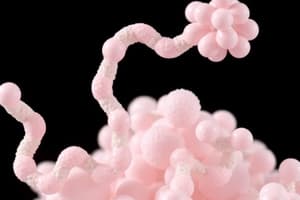Podcast
Questions and Answers
What type of enzyme catalyzes the conversion of one isomer into another?
What type of enzyme catalyzes the conversion of one isomer into another?
- Transferase
- Hydrolase
- Oxidoreductase
- Isomerase (correct)
Which classification of enzyme catalyzes hydrolysis reactions?
Which classification of enzyme catalyzes hydrolysis reactions?
- Oxidoreductase
- Hydrolase (correct)
- Lyase
- Ligase
What defines the nomenclature of enzymes?
What defines the nomenclature of enzymes?
- Determined by their three-dimensional structure
- Derived from their catalytic action and/or the compound they act upon (correct)
- Assigned in a completely arbitrary manner
- Based solely on their substrate
Which type of enzyme is involved in the transfer of a phosphoryl group from one molecule to another?
Which type of enzyme is involved in the transfer of a phosphoryl group from one molecule to another?
How is enzyme specificity primarily determined?
How is enzyme specificity primarily determined?
What is the role of enzymes in biochemical reactions?
What is the role of enzymes in biochemical reactions?
Which of the following enzymes catalyzes the addition of a group to a double bond?
Which of the following enzymes catalyzes the addition of a group to a double bond?
What characteristic of enzymes allows them to increase reaction rates significantly?
What characteristic of enzymes allows them to increase reaction rates significantly?
What concept describes the moment when an enzyme and substrate bind together?
What concept describes the moment when an enzyme and substrate bind together?
Which type of enzyme specificity allows for the catalysis of reactions involving similar molecules?
Which type of enzyme specificity allows for the catalysis of reactions involving similar molecules?
What is the term for the nonprotein component required for an enzyme's catalytic activity?
What is the term for the nonprotein component required for an enzyme's catalytic activity?
What does a high concentration of substrate typically do to an enzyme-catalyzed reaction?
What does a high concentration of substrate typically do to an enzyme-catalyzed reaction?
Which mechanism proposes that the enzyme shape models itself to the substrate?
Which mechanism proposes that the enzyme shape models itself to the substrate?
What term is used to describe allosteric enzymes that bind an effector and change the active site shape to inactive?
What term is used to describe allosteric enzymes that bind an effector and change the active site shape to inactive?
Which type of enzyme specificity catalyzes reactions of only one specific substrate?
Which type of enzyme specificity catalyzes reactions of only one specific substrate?
What is the optimal pH range for lysosomal enzymes to function effectively?
What is the optimal pH range for lysosomal enzymes to function effectively?
What is the primary effect of enzymes on the activation energy of reactions?
What is the primary effect of enzymes on the activation energy of reactions?
Which of the following enzymes acts on a specific type of bond in their substrates?
Which of the following enzymes acts on a specific type of bond in their substrates?
What type of allosterism is characterized by an effector binding that converts the active site to an active configuration?
What type of allosterism is characterized by an effector binding that converts the active site to an active configuration?
Which of the following statements best describes feedback inhibition?
Which of the following statements best describes feedback inhibition?
What is the main role of proenzymes in enzyme activity regulation?
What is the main role of proenzymes in enzyme activity regulation?
Which of the following is NOT a characteristic of allosteric inhibitors?
Which of the following is NOT a characteristic of allosteric inhibitors?
Which process best describes a temporary slowdown in enzyme activity?
Which process best describes a temporary slowdown in enzyme activity?
In the context of enzyme assays, which of the following would be a biomarker for heart disease?
In the context of enzyme assays, which of the following would be a biomarker for heart disease?
Which statement describes the role of adenosine triphosphate in positive allosterism?
Which statement describes the role of adenosine triphosphate in positive allosterism?
What is characteristic of irreversible inhibitors?
What is characteristic of irreversible inhibitors?
Which enzyme modification involves the addition of a functional group to enhance activity?
Which enzyme modification involves the addition of a functional group to enhance activity?
Which enzyme is utilized in clinical laboratories to analyze urea levels?
Which enzyme is utilized in clinical laboratories to analyze urea levels?
What distinguishes noncompetitive inhibitors from competitive inhibitors?
What distinguishes noncompetitive inhibitors from competitive inhibitors?
In enzyme replacement therapy, what is usually administered to patients?
In enzyme replacement therapy, what is usually administered to patients?
Which reaction normally requires a functional enzyme to proceed at significant rates?
Which reaction normally requires a functional enzyme to proceed at significant rates?
Flashcards
Enzyme's effect on activation energy
Enzyme's effect on activation energy
Enzymes lower the activation energy required for a chemical reaction to occur.
Enzyme-substrate complex
Enzyme-substrate complex
The temporary complex formed when an enzyme binds to its substrate.
Lock-and-key model
Lock-and-key model
The enzyme has a rigid 3D active site that fits the substrate perfectly.
Induced-fit model
Induced-fit model
Signup and view all the flashcards
Enzyme specificity
Enzyme specificity
Signup and view all the flashcards
Cofactor
Cofactor
Signup and view all the flashcards
Coenzyme
Coenzyme
Signup and view all the flashcards
Optimal temperature
Optimal temperature
Signup and view all the flashcards
Optimal pH
Optimal pH
Signup and view all the flashcards
Allosteric enzymes
Allosteric enzymes
Signup and view all the flashcards
Enzyme function
Enzyme function
Signup and view all the flashcards
Enzyme characteristics
Enzyme characteristics
Signup and view all the flashcards
Oxidoreductases
Oxidoreductases
Signup and view all the flashcards
Transferases
Transferases
Signup and view all the flashcards
Hydrolases
Hydrolases
Signup and view all the flashcards
Lyases
Lyases
Signup and view all the flashcards
Isomerases
Isomerases
Signup and view all the flashcards
Ligases
Ligases
Signup and view all the flashcards
Positive allosterism
Positive allosterism
Signup and view all the flashcards
Negative allosterism
Negative allosterism
Signup and view all the flashcards
Feedback Inhibition
Feedback Inhibition
Signup and view all the flashcards
Protein Modification
Protein Modification
Signup and view all the flashcards
Competitive Inhibitors
Competitive Inhibitors
Signup and view all the flashcards
Noncompetitive Inhibitors
Noncompetitive Inhibitors
Signup and view all the flashcards
Enzyme Assays
Enzyme Assays
Signup and view all the flashcards
Biomarkers
Biomarkers
Signup and view all the flashcards
Enzyme Replacement Therapy
Enzyme Replacement Therapy
Signup and view all the flashcards
Urea levels in blood
Urea levels in blood
Signup and view all the flashcards
Enzyme assays for diagnosis
Enzyme assays for diagnosis
Signup and view all the flashcards
Study Notes
Enzymes - Lecture 6
- Enzymes are proteins that accelerate biochemical reactions without changing themselves.
- They are large molecules, mostly globular proteins or ribozymes.
- Enzymes significantly increase reaction rates, from 109 to 1020 times.
- They speed up reactions by lowering activation energy.
Enzyme Classifications
- Oxidoreductases: Catalyze oxidation and reduction reactions.
- Example: Lactate dehydrogenase, catalyzes the conversion of lactate to pyruvate.
- Transferases: Catalyze the transfer of a group of atoms between molecules.
- Example: Hexokinase, catalyzes the transfer of a phosphate group from ATP to glucose.
- Hydrolases: Catalyze hydrolysis reactions (breaking bonds with water).
- Example: Lipase catalyzes the hydrolysis of triglycerides into glycerol and fatty acids.
- Lyases: Catalyze the addition of a group to a double bond, or the removal of a group to form a double bond (without water).
- Example: Fumarase catalyzes the addition/removal of water in the transformation of fumarate to malate.
- Isomerases: Catalyze the rearrangement of atoms within a molecule.
- Example: Phosphoglycerate mutase catalyzes the conversion of 3-phosphoglycerate to 2-phosphoglycerate.
- Ligases: Catalyze the joining of two smaller molecules using ATP.
- Example: DNA ligase, joins DNA strands by forming a phosphodiester bond.
Enzyme Nomenclature
- Enzyme names are derived from the reaction they catalyze or the compound they act upon.
- Some enzymes have names based on older naming conventions.
- Example: Pepsin, trypsin, and chymotrypsin are enzymes of the digestive tract.
Enzyme Specificity
- Absolute: Catalyzes the reaction of only one specific substrate.
- Example: Urease catalyzes the hydrolysis of urea.
- Group: Catalyzes the reaction on a specific functional group within a molecule.
- Example: Hexokinase catalyzes the phosphorylation of hexose sugars.
- Linkage: Catalyzes the breaking or formation of a particular chemical bond.
- Example: Proteases (trypsin, chymotrypsin, elastase) catalyze the hydrolysis of peptide bonds.
- Stereochemical: Can distinguish between enantiomers.
- Example: Arginase acts only on the L-enantiomer of arginine.
Enzyme Activity Regulation
- Allosteric Enzymes: Enzymes with multiple binding sites (active and allosteric).
- Allosteric effectors alter enzyme activity by changing the active site's conformation.
- Negative allosterism: Effector binding lowers enzyme activity.
- Positive allosterism: Effector binding increases enzyme activity.
- Example: ATP is a negative allosteric regulator of phosphofructokinase, slowing glycolysis.
- Allosteric effectors alter enzyme activity by changing the active site's conformation.
- Feedback Inhibition: Product of a reaction inhibits an enzyme involved in an earlier step in the reaction sequence.
- Proenzymes (Zymogens): Inactive precursors that become active enzymes after a chemical change.
- Example: Trypsinogen, a zymogen activated to trypsin.
- Protein Modification: Covalent modification of enzymes to regulate their activity.
- Example: Protein kinases add phosphate groups, and phosphatases can remove them to control enzyme activity.
Enzyme Activity Inhibition
- Inhibitors: Substances that reduce or prevent enzyme activity.
- Inhibitors bind to enzymes and reduce their ability to catalyze reactions.
- Competitive inhibitors: Compete with the substrate for the active site.
- Noncompetitive inhibitors: Bind to a site other than the active site, altering the enzyme's conformation.
- Uncompetitive inhibitors: Bind to the enzyme-substrate complex, preventing product formation.
- Examples: Arsenic, snake venom, nerve gases.
- Inhibitors bind to enzymes and reduce their ability to catalyze reactions.
Effect of Temperature and pH
- Enzyme activity is optimal at a specific temperature and pH value.
- Extremes of temperature and pH can denature enzymes, causing them to lose their function.
Enzymes in Medicine
- Useful in diagnoses.
- Enzyme assays are used to analyze blood and bodily fluids during diagnoses.
- Enzyme replacement therapy is used for treating genetic diseases.
Studying That Suits You
Use AI to generate personalized quizzes and flashcards to suit your learning preferences.




